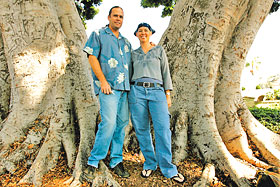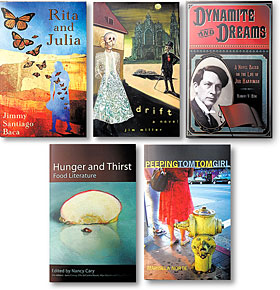
![]()
![]()
From San Diego Union-Tribune (Sept. 28, 2008)
City Book Fair wants to put burgeoning literary
community on the same page
By Roxana Popescu
St. Petersburg had Pushkin. And Nabokov. And Akhmatova. And Brodsky. Not to mention Dostoevsky. (Ah, the Russians!)
Even petite Newburyport, Mass., population 17,000, draws thousands of tourists and over 60 authors to its annual literary festival.
What about San Diego?
 “Authors
just don't come to San Diego. I think their book tours stop
at L.A.,” mused Sydney Brown, a creative-writing assistant
professor at Grossmont College.
“Authors
just don't come to San Diego. I think their book tours stop
at L.A.,” mused Sydney Brown, a creative-writing assistant
professor at Grossmont College.
Not for long. The third annual City Book Fair, run out of a cramped, cozy, book-lined office that could only belong to a pair of literature professors at San Diego City College, has attracted local and national talent – including Carolyn Forché, Quincy Troupe, Jimmy Baca, NPR's Juan Williams, and more than a dozen other writers and filmmakers.
The free weeklong event culminates Saturday with an entire day of lectures and panels at City College's Seville Theatre.
Just in time. City Works Press, a nonprofit publisher affiliated with the fair, has released its four latest books. That is a big jump for the tiny press, considering the normal run is one book per year.
Jim Miller and Kelly Mayhew, founders of City Works and the fair, admit they've been busy this summer. But what's organizing a book fair and quadrupling book production when you're already teaching a full course load at City College and raising a small child? (The couple are married and share an office on campus.)
 The
reason they work 12-hour days and gleefully beg for funding
or attention from anyone who will listen? To turn the phrase
“San Diego literary scene” – which provoked apologetic
chuckles from more than one local writer during interviews –
into less of a contradiction.
The
reason they work 12-hour days and gleefully beg for funding
or attention from anyone who will listen? To turn the phrase
“San Diego literary scene” – which provoked apologetic
chuckles from more than one local writer during interviews –
into less of a contradiction.
“The stereotype of San Diego is that this is a place where people go to the beach, and that there's no culture here,” Miller said. “There're a lot of people doing a lot of small things all over the city. We're trying build a broader, deeper, more vital literary community.”
Of course, writers here know there's more to this city than surf and sprawl.
“If you look for it, it's there,” said Judy Reeves, a founder of San Diego Writers Ink, a nonprofit literary association. She fired off a list of workshops and groups for published and amateur authors, and said the quality of events and journals run by local colleges and universities is outstanding.
But it's hard to get institutional support, Reeves added. Compared with other cities, it is rarer for readers here to meet authors at bookstore readings or lectures. And in a city that's so spread out, it is hard to know what other people are working on.
And so the wishing starts. If only San Diego were a little more like some other cities. Literary ones. Like Seattle or San Francisco, where writers flock for visiting professorships and independent bookstores dot downtown. In an ideal scenario, Reeves mused, “Writers would say, 'Go to San Diego. You get really good crowds, people really care about literature.' ”
That is already starting to happen to a certain extent. In the first two years, attendance at the fair almost doubled, and with it, the outfit's reputation, Mayhew said. As a result, more people are interested in participating this time.
“Some of the writers have told their friends, who told their friends,” she said. “I get a lot of queries, and authors asking me to get on the program. That shows it's getting some word of mouth, not just locally but nationally.”
In the process, she and Miller have gotten a glimpse of a glamorous world where certain authors charge more than this fair's total budget for one reading, and where others demand first-class airfare for two. But many other writers are willing to lower their fees or come for free, especially at a community college.
“I think it's great that at an urban, working class, multiethnic community college you can have a top-flight cultural event,” Miller said. “We wanted to do an event that both reflected our populations and also served them.”
Book fairs have become more popular in the past decade, as communities are discovering that literacy can be lucrative.
“I've received a lot of calls from smaller fairs wanting to know about how to increase their size,” said Ana Jones, an organizer of Florida's 25-year-old Miami Book Fair, considered the mother ship for aspiring newbies.
The biggest challenge for the San Diego organizers has been finding funding, because many of last year's donors are struggling in the current economy. The Miami fair, with a budget of over $1 million, charges $5 per day and is funded largely through sponsors like Target.
“Most book fairs do use corporate sponsorship,” Jones said. “It's just a natural inclination. Start local and go national.”
Early on, Miller and Mayhew decided against corporate sponsorship because that would compromise their mission – to start and stay local.
“We're not forgetting where we came from,” Miller said. Although it's set at a community college, the Miami fair, he added, is so large it could alienate students, whereas City College students will get to meet privately with certain authors this week.
Merchant booths, which typically cost several hundred dollars at street fairs, are also free. So will be the coffee from Peet's Coffee & Tea and food from Hash House A Go Go in Hillcrest.
“As long as we can, we'd like to continue offering free booths, because they're having a tough time economically, and having independent sellers is part of our local identity,” Miller said.Brown, the creative writing professor, will take her poetry class to Saturday's readings by Carolyn Forché and Li-Young Lee because “so rarely do my students get to meet writers.”
“I often think that if there would have been stuff like this when I got out of high school, I would have been nourished by that earlier and figured out what I wanted to do for a career,” she said.
Terrence Burgess, president of San Diego City College and an almost-English major in college before defecting to biology (“I was a total Faulkner freak,” he confessed), said the idea for the fair grew out of City Works Press and what he heard about Miami's fair. Besides the fair, he's working to establish a literacy center that will boost the campus's cultural offerings considerably.
More than a decade ago, he said, the college launched City Works Journal and a reading series to showcase creative writing, art and poetry by students and local writers. Miller and Mayhew decided to assemble the submissions more formally, and the press was born. They collected $25,000 in seed money, and the first book, a short story collection about San Diego, sold out rapidly.
The press has published one book every year, and the latest large run, which includes an anthology about food (“Hunger and Thirst”) and a collection by spoken word poet Marisela Norte (“Peeping Tom Tom Girl”), was something of a surprise. Nor did they expect instant success.
“Even before the books hit stores, they sold almost 1,000 copies online,” Miller said.
Brown says the press offers a valuable perspective at a time when independent publishers are increasingly rare.
“We're often considered the biggest small town in America, so it's nice to see some diversity and so many voices. The press shows that 'other' side, not mainstream San Diego.”
The “other” San Diego is exactly what Miller hopes the fair will unleash. East Village is edgy and vibrant these days, downtown has become a national destination, people appear to be hungry for literature, so some interesting collisions could arise.
“We'd like to serve as a cultural nexus,” he said, “a model of intersecting city communities.”
Copyright © 2008 City Works Press. All rights reserved.